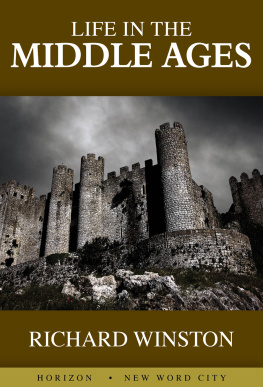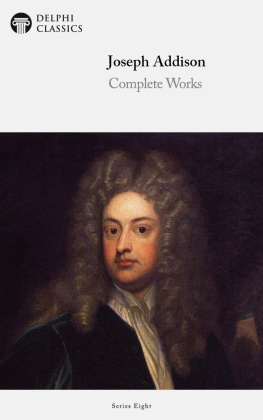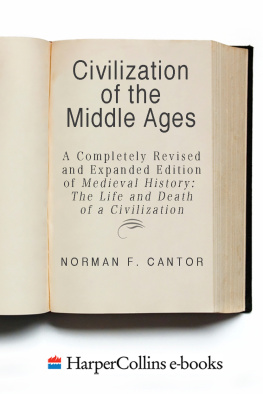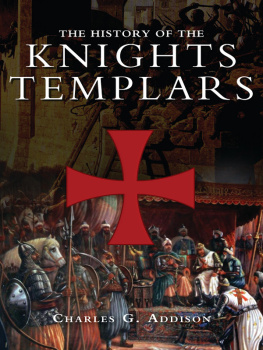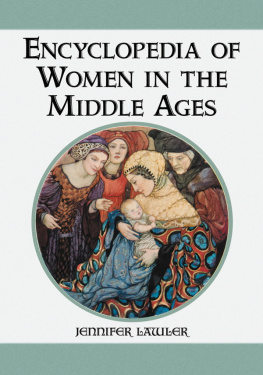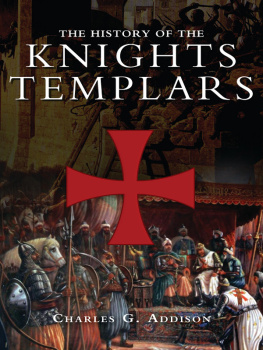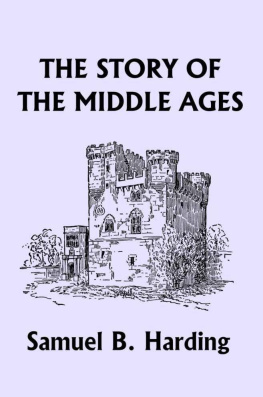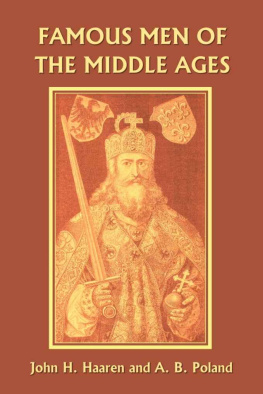Poland Addison B. - Famous men of the middle ages
Here you can read online Poland Addison B. - Famous men of the middle ages full text of the book (entire story) in english for free. Download pdf and epub, get meaning, cover and reviews about this ebook. City: New York, Europe, Europe, year: 1904, publisher: American Book Co, genre: History. Description of the work, (preface) as well as reviews are available. Best literature library LitArk.com created for fans of good reading and offers a wide selection of genres:
Romance novel
Science fiction
Adventure
Detective
Science
History
Home and family
Prose
Art
Politics
Computer
Non-fiction
Religion
Business
Children
Humor
Choose a favorite category and find really read worthwhile books. Enjoy immersion in the world of imagination, feel the emotions of the characters or learn something new for yourself, make an fascinating discovery.
- Book:Famous men of the middle ages
- Author:
- Publisher:American Book Co
- Genre:
- Year:1904
- City:New York, Europe, Europe
- Rating:3 / 5
- Favourites:Add to favourites
- Your mark:
- 60
- 1
- 2
- 3
- 4
- 5
Famous men of the middle ages: summary, description and annotation
We offer to read an annotation, description, summary or preface (depends on what the author of the book "Famous men of the middle ages" wrote himself). If you haven't found the necessary information about the book — write in the comments, we will try to find it.
Famous men of the middle ages — read online for free the complete book (whole text) full work
Below is the text of the book, divided by pages. System saving the place of the last page read, allows you to conveniently read the book "Famous men of the middle ages" online for free, without having to search again every time where you left off. Put a bookmark, and you can go to the page where you finished reading at any time.
Font size:
Interval:
Bookmark:
The Project Gutenberg EBook of Famous Men of the Middle Ages, by
John H. Haaren and A. B. Poland
This eBook is for the use of anyone anywhere at no cost and with
almost no restrictions whatsoever. You may copy it, give it away or
re-use it under the terms of the Project Gutenberg License included
with this eBook or online at www.gutenberg.net
Title: Famous Men of the Middle Ages
Author: John H. Haaren
A. B. Poland
Posting Date: March 10, 2010 [EBook #3725]
Release Date: February, 2003
Language: English
*** START OF THIS PROJECT GUTENBERG EBOOK FAMOUS MEN OF THE MIDDLE AGES ***
Original version produced by Brett Fishburne
and Jenny Francisco. Corrected and updated version, and
illustrated HTML version, prepared by Robert J. Hall.
Typed by Brett Fishburne (william.fishburne@verizon.net)
Proofed by Jenny Francisco (seattle717@yahoo.com)
OF
THE MIDDLE AGES
By
JOHN H. HAAREN, LL.D.
District Superintendent of Schools
The City of New York
and
A. B. POLAND, Ph.D.
Superintendent of Schools
Newark N. J.
The study of history, like the study of a landscape, should begin with the most conspicuous features. Not until these have been fixed in memory will the lesser features fall into their appropriate places and assume their right proportions.
The famous men of ancient and modern times are the mountain peaks of history. It is logical then that the study of history should begin with the biographies of these men.
Not only is it logical; it is also pedagogical. Experience has proven that in order to attract and hold the child's attention each conspicuous feature of history presented to him should have an individual for its center. The child identifies himself with the personage presented. It is not Romulus or Hercules or Csar or Alexander that the child has in mind when he reads, but himself, acting under similar conditions.
Prominent educators, appreciating these truths, have long recognized the value of biography as a preparation for the study of history and have given it an important place in their scheme of studies.
The former practice in many elementary schools of beginning the detailed study of American history without any previous knowledge of general history limited the pupil's range of vision, restricted his sympathies, and left him without material for comparisons. Moreover, it denied to him a knowledge of his inheritance from the Greek philosopher, the Roman lawgiver, the Teutonic lover of freedom. Hence the recommendation so strongly urged in the report of the Page 4 Committee of Tenand emphasized, also, in the report of the Committee of Fifteenthat the study of Greek, Roman and modern European history in the form of biography should precede the study of detailed American history in our elementary schools. The Committee of Ten recommends an eight years' course in history, beginning with the fifth year in school and continuing to the end of the high school course. The first two years of this course are given wholly to the study of biography and mythology. The Committee of fifteen recommends that history be taught in all the grades of the elementary school and emphasizes the value of biography and of general history.
The series of historical stories to which this volume belongs was prepared in conformity with the foregoing recommendations and with the best practice of leading schools. It has been the aim of the authors to make an interesting story of each man's life and to tell these stories in a style so simple that pupils in the lower grades will read them with pleasure, and so dignified that they may be used with profit as text-books for reading.
Teachers who find it impracticable to give to the study of mythology and biography a place of its own in an already overcrowded curriculum usually prefer to correlate history with reading and for this purpose the volumes of this series will be found most desirable.
The value of the illustrations can scarcely be over-estimated. They will be found to surpass in number and excellence anything heretofore offered in a school-book. For the most part they are reproductions of world-famous pictures, and for that reason the artists' names are generally affixed.
| Introduction | |
| The Gods of the Teutons | |
| The Nibelungs | |
| Chapter | |
| I | Alaric the Visigoth (394-410 A.D.) |
| II | Attila the Hun (433-453 A.D.) |
| III | Genseric the Vandal (427-477 A.D.) |
| IV | Theodoric the Ostrogoth (475-526 A.D.) |
| V | Clovis (481-511 A.D.) |
| VI | Justinian (527-565 A.D.) |
| VII | Mohammed (570-632 A.D.) |
| VIII | Charles Martel and Pepin (714-768 A.D.) |
| IX | Charlemagne (768-809 A.D.) |
| X | Harun-al-Raschid (786-809 A.D.) |
| XI | Egbert the Saxon (802-837 A.D.) |
| XII | Rollo the Viking (Died 931 A.D.) |
| XIII | Alfred the Great (871-901 A.D.) |
| XIV | Henry the Fowler (919-936 A.D.) |
| XV | Canute the Great (1014-1035) |
| XVI | The Cid (1040-1099) |
| XVII | Page 6 Edward the Confessor (1042-1066) |
| XVIII | William the Conqueror (1066-1087) |
| XIX | Peter the Hermit (1050-1115) |
| XX | Frederick Barbarossa (1152-1190) |
| XXI | Henry the Second and His Sons (1154-1216) |
| XXII | Louis IX (1226-1270) |
| XXIII | Robert Bruce (1306-1329) |
| XXIV | Marco Polo (1254-1324) |
| XXIV | Edward the Black Prince (1330-1376) |
| XXVI | William Tell and Arnold von Winkelried (1300-1386) |
| XXVII | Tamerlane (1333-1405) |
| XXVIII | Henry V (1413-1422) |
| XXIX | Joan of Arc (1412-1431) |
| XXX | Gutenberg (1400-1468) |
| XXXI | Warwick the King-Maker (1428-1471) |
Page 7 INTRODUCTION
In the little volume called The Famous Men of Rome you have read about the great empire which the Romans established. Now we come to a time when the power of Rome was broken and tribes of barbarians who lived north of the Danube and the Rhine took possession of lands that had been part of the Roman Empire. These tribes were the Goths, Vandals, Huns, Franks and Anglo-Saxons. From them have come the greatest nations of modern times. All except the Huns belonged to the same race and are known as Teutons. They were war-like, savage and cruel. They spoke the same languagethough in different dialectsand worshiped the same gods. Like the old Greeks and Romans they had many gods.
Woden, who was also called Odin, was the greatest of all. His name means "mighty warrior," and he was king of all the gods. He rode through the Page 8 air mounted on Sleip'nir, an eight-footed horse fleeter than the eagle. When the tempest roared the Teutons said it was the snorting of Sleipnir. When their ships came safely into port they said it was Woden's breath that had filled their sails and wafted their vessels over the blue waters.
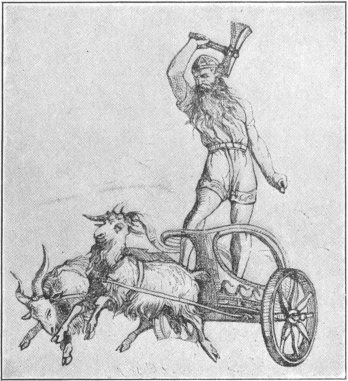 |
| THOR THROWING HIS HAMMER |
Thor, a son of Woden, ranked next to him among the gods. He rode through the air in a chariot drawn by goats. The Germans called him Donar and Thunar, words which are like our word thunder. From this we can see that he was the thunder god. In his hand he carried a wonderful hammer which always came back to his hand when he threw it. Its head was so bright that as it flew through the air it made the lightning. When it struck the vast ice mountains they reeled and splintered into fragments, and thus Thor's hammer made thunder.
Font size:
Interval:
Bookmark:
Similar books «Famous men of the middle ages»
Look at similar books to Famous men of the middle ages. We have selected literature similar in name and meaning in the hope of providing readers with more options to find new, interesting, not yet read works.
Discussion, reviews of the book Famous men of the middle ages and just readers' own opinions. Leave your comments, write what you think about the work, its meaning or the main characters. Specify what exactly you liked and what you didn't like, and why you think so.




